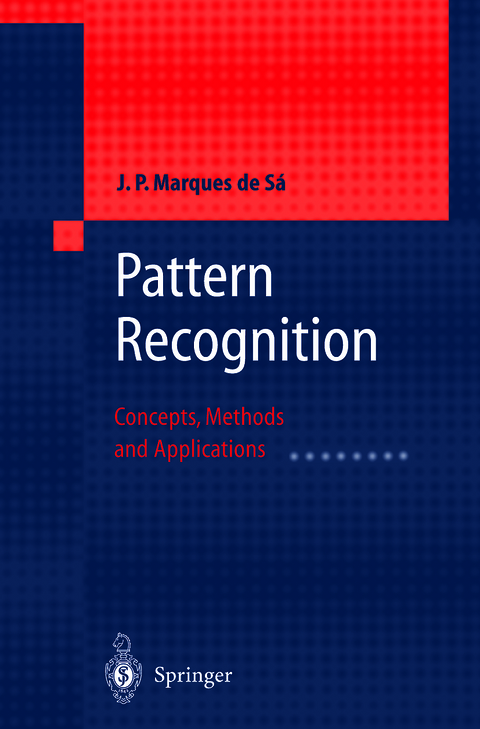
Pattern Recognition
Springer Berlin (Verlag)
978-3-642-62677-7 (ISBN)
1 Basic Notions.- 1.1 Object Recognition.- 1.2 Pattern Similarity and PR Tasks.- 1.3 Classes, Patterns and Features.- 1.4 PR Approaches.- 1.5 PR Project.- 2 Pattern Discrimination.- 2.1 Decision Regions and Functions.- 2.2 Feature Space Metrics.- 2.3 The Covariance Matrix.- 2.4 Principal Components.- 2.5 Feature Assessment.- 2.6 The Dimensionality Ratio Problem.- Exercises.- 3 Data Clustering.- 3.1 Unsupervised Classification.- 3.2 The Standardization Issue.- 3.3 Tree Clustering.- 3.4 Dimensional Reduction.- 3.5 K-Means Clustering.- 3.6 Cluster Validation.- Exercises.- 4 Statistical Classification.- 4.1 Linear Discriminants.- 4.2 Bayesian Classification.- 4.3 Model-Free Techniques.- 4.4 Feature Selection.- 4.5 Classifier Evaluation.- 4.6 Tree Classifiers.- 4.7 Statistical Classifiers in Data Mining.- Exercises.- 5 Neural Networks.- 5.1 LMS Adjusted Discriminants.- 5.2 Activation Functions.- 5.3 The Perceptron Concept.- 5.4 Neural Network Types.- 5.5 Multi-Layer Perceptrons.- 5.6 Performance of Neural Networks.- 5.7 Approximation Methods in NN Training.- 5.8 Genetic Algorithms in NN Training.- 5.9 Radial Basis Functions.- 5.10 Support Vector Machines.- 5.11 Kohonen Networks.- 5.12 Hopfield Networks.- 5.13 Modular Neural Networks.- 5.14 Neural Networks in Data Mining.- Exercises.- 6 Structural Pattern Recognition.- 6.1 Pattern Primitives.- 6.2 Structural Representations.- 6.3 Syntactic Analysis.- 6.4 Structural Matching.- Exercises.- Appendix A-CD Datasets.- A.1 Breast Tissue.- A.2 Clusters.- A.3 Cork Stoppers.- A.4 Crimes.- A.5 Cardiotocographic Data.- A.6 Electrocardiograms.- A.7 Foetal Heart Rate Signals.- A.8 FHR-Apgar.- A.9 Firms.- A.10 Foetal Weight.- A.11 Food.- A.12 Fruits.- A.13 Impulses on Noise.- A.14 MLP Sets.- A.15 Norm2c2d.- A.16 Rocks.- A.17 StockExchange.- A.18 Tanks.- A.19 Weather.- Appendix B-CD Tools.- B.1 Adaptive Filtering.- B.2 Density Estimation.- B.3 Design Set Size.- B.4 Error Energy.- B.5 Genetic Neural Networks.- B.6 Hopfield network.- B.7 k-NN Bounds.- B.8 k-NN Classification.- B.9 Perceptron.- B.10 Syntactic Analysis.- Appendix C-Orthonormal Transformation.- Appendix C-Orthonormal Transformation.
From the reviews of the first edition:
"The book gives an overview about the wide field of pattern recognition. ... The book is primarily addressed to undergraduate and graduate students of engineering and computer science courses. It gives a good introduction into the field of clustering and pattern recognition." (Hans-Peter Altenburg, Zentralblatt MATH, Vol. 1009, 2003)
"'Patern Recognition' presents methods and techniques that are suitable for practical application in areas including robot assisted manufacture, medical diagnostic systems, forecast of economic variables, exploration of Earth's resources, and satellite data analysis. ... This book provides comprehensive, non-specialist coverage of pattern recognition. Although primarily aimed at undergraduate and graduate engineering and computer science students, its clear and practical coverage also makes it suitable for physicians, biologists, geologists and economists." (Assembly Automation, Vol. 22 (4), 2002)
| Erscheint lt. Verlag | 5.12.2012 |
|---|---|
| Zusatzinfo | XIX, 318 p. 198 illus., 3 illus. in color. |
| Verlagsort | Berlin |
| Sprache | englisch |
| Maße | 155 x 235 mm |
| Gewicht | 528 g |
| Themenwelt | Informatik ► Grafik / Design ► Digitale Bildverarbeitung |
| Informatik ► Theorie / Studium ► Künstliche Intelligenz / Robotik | |
| Medizinische Fachgebiete ► Radiologie / Bildgebende Verfahren ► Radiologie | |
| Technik ► Elektrotechnik / Energietechnik | |
| Schlagworte | algorithms • classification • filtering • Genetic algorithms • Image Analysis • Image Processing • metrics • Pattern Analysis • pattern recognition • Performance • Support Vector Machine |
| ISBN-10 | 3-642-62677-7 / 3642626777 |
| ISBN-13 | 978-3-642-62677-7 / 9783642626777 |
| Zustand | Neuware |
| Informationen gemäß Produktsicherheitsverordnung (GPSR) | |
| Haben Sie eine Frage zum Produkt? |
aus dem Bereich


